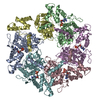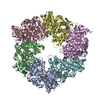[English] 日本語
 Yorodumi
Yorodumi- PDB-6fo1: Human R2TP subcomplex containing 1 RUVBL1-RUVBL2 hexamer bound to... -
+ Open data
Open data
- Basic information
Basic information
| Entry | Database: PDB / ID: 6fo1 | ||||||||||||||||||||||||||||||||||||||||||||||||||||||||||||||||||
|---|---|---|---|---|---|---|---|---|---|---|---|---|---|---|---|---|---|---|---|---|---|---|---|---|---|---|---|---|---|---|---|---|---|---|---|---|---|---|---|---|---|---|---|---|---|---|---|---|---|---|---|---|---|---|---|---|---|---|---|---|---|---|---|---|---|---|---|
| Title | Human R2TP subcomplex containing 1 RUVBL1-RUVBL2 hexamer bound to 1 RBD domain from RPAP3. | ||||||||||||||||||||||||||||||||||||||||||||||||||||||||||||||||||
 Components Components |
| ||||||||||||||||||||||||||||||||||||||||||||||||||||||||||||||||||
 Keywords Keywords | CHAPERONE / R2TP / HSP90 co-chaperone / PIH1D1 / RPAP3 / RUVBL1-RUVBL2 | ||||||||||||||||||||||||||||||||||||||||||||||||||||||||||||||||||
| Function / homology |  Function and homology information Function and homology informationpromoter-enhancer loop anchoring activity / telomerase RNA localization to Cajal body / regulation of DNA strand elongation / positive regulation of telomere maintenance in response to DNA damage / establishment of protein localization to chromatin / R2TP complex / dynein axonemal particle / RPAP3/R2TP/prefoldin-like complex / Swr1 complex / Ino80 complex ...promoter-enhancer loop anchoring activity / telomerase RNA localization to Cajal body / regulation of DNA strand elongation / positive regulation of telomere maintenance in response to DNA damage / establishment of protein localization to chromatin / R2TP complex / dynein axonemal particle / RPAP3/R2TP/prefoldin-like complex / Swr1 complex / Ino80 complex / regulation of double-strand break repair / box C/D snoRNP assembly / protein folding chaperone complex / regulation of chromosome organization / NuA4 histone acetyltransferase complex / TFIID-class transcription factor complex binding / regulation of DNA replication / MLL1 complex / regulation of embryonic development / Telomere Extension By Telomerase / RNA polymerase II core promoter sequence-specific DNA binding / regulation of DNA repair / positive regulation of double-strand break repair via homologous recombination / Deposition of new CENPA-containing nucleosomes at the centromere / DNA helicase activity / telomere maintenance / TBP-class protein binding / positive regulation of DNA repair / cellular response to estradiol stimulus / euchromatin / negative regulation of canonical Wnt signaling pathway / Formation of the beta-catenin:TCF transactivating complex / beta-catenin binding / ADP binding / chromatin DNA binding / DNA Damage Recognition in GG-NER / nuclear matrix / cellular response to UV / UCH proteinases / transcription corepressor activity / unfolded protein binding / positive regulation of canonical Wnt signaling pathway / protein folding / nucleosome / HATs acetylate histones / ATPase binding / regulation of apoptotic process / DNA recombination / spermatogenesis / DNA helicase / transcription coactivator activity / regulation of cell cycle / Ub-specific processing proteases / protein stabilization / nuclear speck / cilium / ciliary basal body / cadherin binding / RNA polymerase II cis-regulatory region sequence-specific DNA binding / chromatin remodeling / ribonucleoprotein complex / cell division / DNA repair / centrosome / regulation of DNA-templated transcription / regulation of transcription by RNA polymerase II / positive regulation of DNA-templated transcription / protein homodimerization activity / positive regulation of transcription by RNA polymerase II / ATP hydrolysis activity / extracellular exosome / nucleoplasm / ATP binding / identical protein binding / nucleus / membrane / cytosol / cytoplasm Similarity search - Function | ||||||||||||||||||||||||||||||||||||||||||||||||||||||||||||||||||
| Biological species |  Homo sapiens (human) Homo sapiens (human) | ||||||||||||||||||||||||||||||||||||||||||||||||||||||||||||||||||
| Method | ELECTRON MICROSCOPY / single particle reconstruction / cryo EM / Resolution: 3.57 Å | ||||||||||||||||||||||||||||||||||||||||||||||||||||||||||||||||||
 Authors Authors | Martino, F. / Munoz-Hernandez, H. / Rodriguez, C.F. / Pearl, L.H. / Llorca, O. | ||||||||||||||||||||||||||||||||||||||||||||||||||||||||||||||||||
| Funding support |  Spain, 3items Spain, 3items
| ||||||||||||||||||||||||||||||||||||||||||||||||||||||||||||||||||
 Citation Citation |  Journal: Nat Commun / Year: 2018 Journal: Nat Commun / Year: 2018Title: RPAP3 provides a flexible scaffold for coupling HSP90 to the human R2TP co-chaperone complex. Authors: Fabrizio Martino / Mohinder Pal / Hugo Muñoz-Hernández / Carlos F Rodríguez / Rafael Núñez-Ramírez / David Gil-Carton / Gianluca Degliesposti / J Mark Skehel / S Mark Roe / ...Authors: Fabrizio Martino / Mohinder Pal / Hugo Muñoz-Hernández / Carlos F Rodríguez / Rafael Núñez-Ramírez / David Gil-Carton / Gianluca Degliesposti / J Mark Skehel / S Mark Roe / Chrisostomos Prodromou / Laurence H Pearl / Oscar Llorca /   Abstract: The R2TP/Prefoldin-like co-chaperone, in concert with HSP90, facilitates assembly and cellular stability of RNA polymerase II, and complexes of PI3-kinase-like kinases such as mTOR. However, the ...The R2TP/Prefoldin-like co-chaperone, in concert with HSP90, facilitates assembly and cellular stability of RNA polymerase II, and complexes of PI3-kinase-like kinases such as mTOR. However, the mechanism by which this occurs is poorly understood. Here we use cryo-EM and biochemical studies on the human R2TP core (RUVBL1-RUVBL2-RPAP3-PIH1D1) which reveal the distinctive role of RPAP3, distinguishing metazoan R2TP from the smaller yeast equivalent. RPAP3 spans both faces of a single RUVBL ring, providing an extended scaffold that recruits clients and provides a flexible tether for HSP90. A 3.6 Å cryo-EM structure reveals direct interaction of a C-terminal domain of RPAP3 and the ATPase domain of RUVBL2, necessary for human R2TP assembly but absent from yeast. The mobile TPR domains of RPAP3 map to the opposite face of the ring, associating with PIH1D1, which mediates client protein recruitment. Thus, RPAP3 provides a flexible platform for bringing HSP90 into proximity with diverse client proteins. | ||||||||||||||||||||||||||||||||||||||||||||||||||||||||||||||||||
| History |
|
- Structure visualization
Structure visualization
| Movie |
 Movie viewer Movie viewer |
|---|---|
| Structure viewer | Molecule:  Molmil Molmil Jmol/JSmol Jmol/JSmol |
- Downloads & links
Downloads & links
- Download
Download
| PDBx/mmCIF format |  6fo1.cif.gz 6fo1.cif.gz | 369.8 KB | Display |  PDBx/mmCIF format PDBx/mmCIF format |
|---|---|---|---|---|
| PDB format |  pdb6fo1.ent.gz pdb6fo1.ent.gz | 291 KB | Display |  PDB format PDB format |
| PDBx/mmJSON format |  6fo1.json.gz 6fo1.json.gz | Tree view |  PDBx/mmJSON format PDBx/mmJSON format | |
| Others |  Other downloads Other downloads |
-Validation report
| Summary document |  6fo1_validation.pdf.gz 6fo1_validation.pdf.gz | 1.2 MB | Display |  wwPDB validaton report wwPDB validaton report |
|---|---|---|---|---|
| Full document |  6fo1_full_validation.pdf.gz 6fo1_full_validation.pdf.gz | 1.3 MB | Display | |
| Data in XML |  6fo1_validation.xml.gz 6fo1_validation.xml.gz | 69.7 KB | Display | |
| Data in CIF |  6fo1_validation.cif.gz 6fo1_validation.cif.gz | 104.4 KB | Display | |
| Arichive directory |  https://data.pdbj.org/pub/pdb/validation_reports/fo/6fo1 https://data.pdbj.org/pub/pdb/validation_reports/fo/6fo1 ftp://data.pdbj.org/pub/pdb/validation_reports/fo/6fo1 ftp://data.pdbj.org/pub/pdb/validation_reports/fo/6fo1 | HTTPS FTP |
-Related structure data
| Related structure data |  4287MC  4289C  4290C  4291C M: map data used to model this data C: citing same article ( |
|---|---|
| Similar structure data |
- Links
Links
- Assembly
Assembly
| Deposited unit | 
|
|---|---|
| 1 |
|
- Components
Components
| #1: Protein | Mass: 50296.914 Da / Num. of mol.: 3 Source method: isolated from a genetically manipulated source Source: (gene. exp.)  Homo sapiens (human) / Gene: RUVBL1, INO80H, NMP238, TIP49, TIP49A / Production host: Homo sapiens (human) / Gene: RUVBL1, INO80H, NMP238, TIP49, TIP49A / Production host:  #2: Protein | Mass: 51222.465 Da / Num. of mol.: 3 Source method: isolated from a genetically manipulated source Source: (gene. exp.)  Homo sapiens (human) / Gene: RUVBL2, INO80J, TIP48, TIP49B, CGI-46 / Production host: Homo sapiens (human) / Gene: RUVBL2, INO80J, TIP48, TIP49B, CGI-46 / Production host:  #3: Protein | | Mass: 75830.547 Da / Num. of mol.: 1 Source method: isolated from a genetically manipulated source Details: MTSANKAIELQLQVKQNAEELQDFMRDLENWEKDIKQKDMELRRQNGVPEENLPPIRNGN FRKKKKGKAKESSKKTREENTKNRIKSYDYEAWAKLDVDRILDELDKDDSTHESLSQESE SEEDGIHVDSQKALVLKEKGNKYFKQGKYDEAIDCYTKGMDADPYNPVLPTNRASAYFRL ...Details: MTSANKAIELQLQVKQNAEELQDFMRDLENWEKDIKQKDMELRRQNGVPEENLPPIRNGN FRKKKKGKAKESSKKTREENTKNRIKSYDYEAWAKLDVDRILDELDKDDSTHESLSQESE SEEDGIHVDSQKALVLKEKGNKYFKQGKYDEAIDCYTKGMDADPYNPVLPTNRASAYFRL KKFAVAESDCNLAVALNRSYTKAYSRRGAARFALQKLEEAKKDYERVLELEPNNFEATNE LRKISQALASKENSYPKEADIVIKSTEGERKQIEAQQNKQQAISEKDRGNGFFKEGKYER AIECYTRGIAADGANALLPANRAMAYLKIQKYEEAEKDCTQAILLDGSYSKAFARRGTAR TFLGKLNEAKQDFETVLLLEPGNKQAVTELSKIKKELIEKGHWDDVFLDSTQRQNVVKPI DNPPHPGSTKPLKKVIIEETGNLIQTIDVPDSTTAAAPENNPINLANVIAATGTTSKKNS SQDDLFPTSDTPRAKVLKIEEVSDTSSLQPQASLKQDVCQSYSEKMPIEIEQKPAQFATT VLPPIPANSFQLESDFRQLKSSPDMLYQYLKQIEPSLYPKLFQKNLDPDVFNQIVKILHD FYIEKEKPLLIFEILQRLSELKRFDMAVMFMSETEKKIARALFNHIDKSGLKDSSVEELK KRYGG Source: (gene. exp.)  Homo sapiens (human) / Gene: RPAP3 / Production host: Homo sapiens (human) / Gene: RPAP3 / Production host:  #4: Chemical | ChemComp-ADP / Has protein modification | N | |
|---|
-Experimental details
-Experiment
| Experiment | Method: ELECTRON MICROSCOPY |
|---|---|
| EM experiment | Aggregation state: PARTICLE / 3D reconstruction method: single particle reconstruction |
- Sample preparation
Sample preparation
| Component | Name: a human R2TP subcomplex containing 1 RUVBL1-RUVBL2 hexamer bound to 1 RBD domain of RPAP3 Type: COMPLEX / Entity ID: #1-#3 / Source: RECOMBINANT | |||||||||||||||||||||||||
|---|---|---|---|---|---|---|---|---|---|---|---|---|---|---|---|---|---|---|---|---|---|---|---|---|---|---|
| Molecular weight | Experimental value: NO | |||||||||||||||||||||||||
| Source (natural) | Organism:  Homo sapiens (human) Homo sapiens (human) | |||||||||||||||||||||||||
| Source (recombinant) | Organism:  | |||||||||||||||||||||||||
| Buffer solution | pH: 7.8 | |||||||||||||||||||||||||
| Buffer component |
| |||||||||||||||||||||||||
| Specimen | Embedding applied: NO / Shadowing applied: NO / Staining applied: NO / Vitrification applied: YES | |||||||||||||||||||||||||
| Specimen support | Grid material: COPPER / Grid type: Quantifoil R1.2/1.3 | |||||||||||||||||||||||||
| Vitrification | Instrument: FEI VITROBOT MARK IV / Cryogen name: ETHANE |
- Electron microscopy imaging
Electron microscopy imaging
| Experimental equipment |  Model: Titan Krios / Image courtesy: FEI Company |
|---|---|
| Microscopy | Model: FEI TITAN KRIOS |
| Electron gun | Electron source:  FIELD EMISSION GUN / Accelerating voltage: 300 kV / Illumination mode: FLOOD BEAM FIELD EMISSION GUN / Accelerating voltage: 300 kV / Illumination mode: FLOOD BEAM |
| Electron lens | Mode: BRIGHT FIELD |
| Specimen holder | Cryogen: NITROGEN / Specimen holder model: FEI TITAN KRIOS AUTOGRID HOLDER |
| Image recording | Electron dose: 52 e/Å2 / Detector mode: COUNTING / Film or detector model: GATAN K2 SUMMIT (4k x 4k) |
| Image scans | Movie frames/image: 32 |
- Processing
Processing
| Software | Name: PHENIX / Version: 1.13-2998_final: / Classification: refinement | ||||||||||||||||||||||||||||||||||||||||
|---|---|---|---|---|---|---|---|---|---|---|---|---|---|---|---|---|---|---|---|---|---|---|---|---|---|---|---|---|---|---|---|---|---|---|---|---|---|---|---|---|---|
| EM software |
| ||||||||||||||||||||||||||||||||||||||||
| CTF correction | Type: PHASE FLIPPING AND AMPLITUDE CORRECTION | ||||||||||||||||||||||||||||||||||||||||
| Symmetry | Point symmetry: C1 (asymmetric) | ||||||||||||||||||||||||||||||||||||||||
| 3D reconstruction | Resolution: 3.57 Å / Resolution method: FSC 0.143 CUT-OFF / Num. of particles: 101742 / Symmetry type: POINT | ||||||||||||||||||||||||||||||||||||||||
| Atomic model building | Protocol: FLEXIBLE FIT | ||||||||||||||||||||||||||||||||||||||||
| Refine LS restraints |
|
 Movie
Movie Controller
Controller










 PDBj
PDBj







